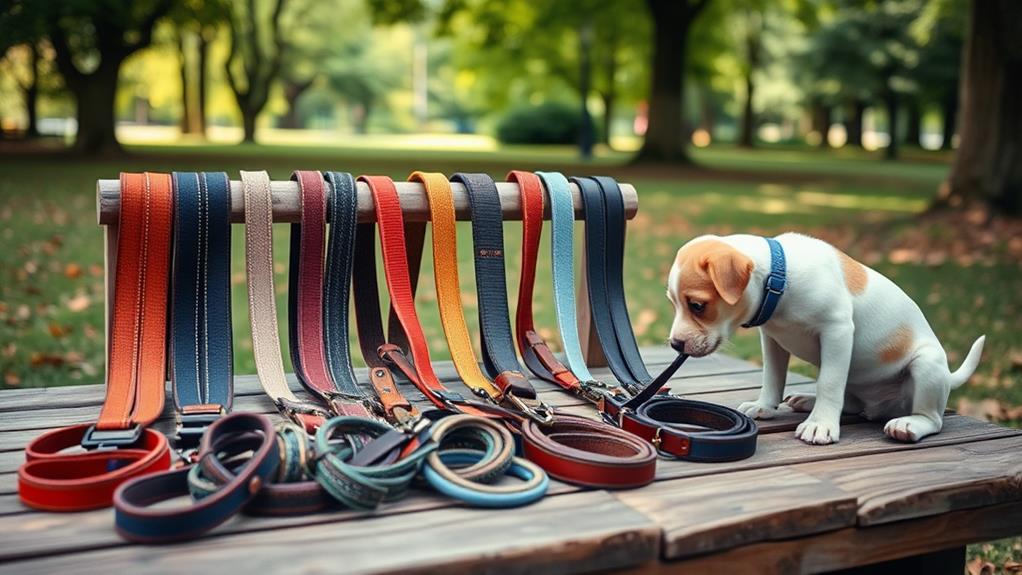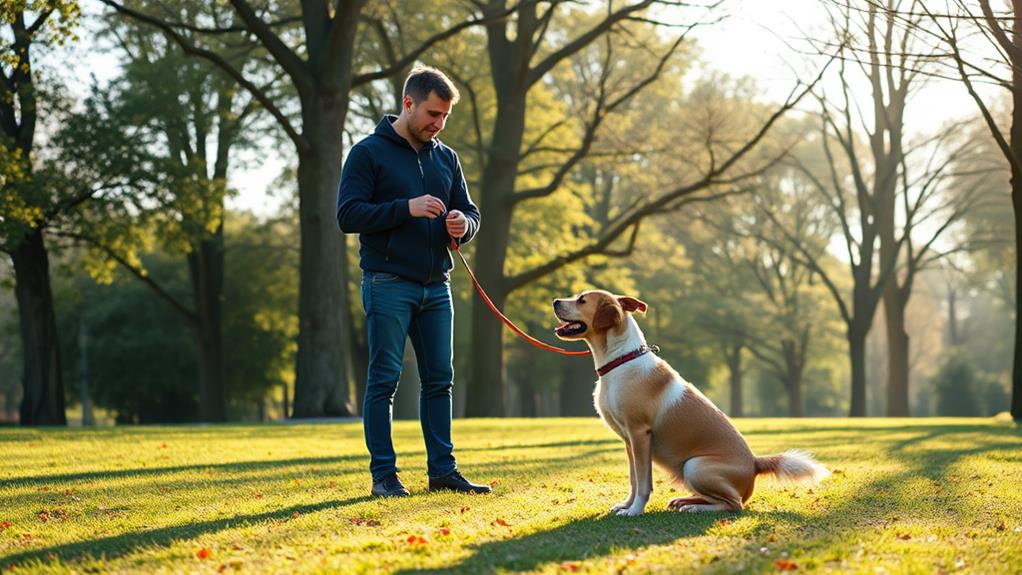For stress-free walks, start with the right leash that suits your dog's size and strength. Observe your dog's behavior to identify triggers and adjust your approach. Begin training indoors in a quiet space, focusing on short sessions with positive reinforcement. Practice loose leash walking and stop if your dog pulls, rewarding them when they stay close. Gradually expose your dog to distractions and increase the difficulty of your walks. Regular practice is key, and keeping walks enjoyable makes a big difference. Stick around to discover more tips to enhance your leash training experience!
Choose the Right Leash

When it comes to choosing the right leash, how do you know what's best for your dog? First, consider your dog's size and strength. A lightweight leash might work for a small dog, but a larger, stronger dog may require a thicker, more durable leash to handle their pulling.
Next, think about the material. Nylon leashes are popular due to their durability and variety of styles, while leather offers a classic feel but may require more maintenance.
Length is another pivotal factor. A shorter leash gives you better control, which is ideal for training or busy environments. On the other hand, a longer leash allows your dog more freedom to explore while still keeping them safe.
Finally, don't overlook the type of leash clip. A sturdy, secure clip is essential to prevent any unexpected escapes. If you're considering a retractable leash, ensure you're comfortable managing it, as they can be tricky for beginners.
Ultimately, choosing the right leash is about finding a balance between control, comfort, and suitability for your dog's behavior. Test a few options to see what works best for both of you!
Understand Your Dog's Behavior

Understanding your dog's behavior is key to effective leash training. Every dog has a unique personality and set of reactions to the world around them. By observing your dog closely, you can identify their triggers—like other dogs, people, or even specific sounds. This awareness helps you anticipate their reactions during walks, making it easier to manage their behavior.
Pay attention to your dog's body language. A wagging tail doesn't always mean they're happy; it can also signal excitement or anxiety. Similarly, if your dog freezes or pulls back, it might indicate fear or discomfort. Recognizing these signs allows you to adjust your approach, whether that means providing reassurance or redirecting their focus.
Also, consider your dog's energy levels. Some dogs thrive on high-energy activities, while others may prefer a more relaxed pace. Matching your walking style to your dog's needs can greatly improve your walks together.
Start Training Indoors

Starting your leash training indoors can be a game-changer for both you and your dog. By beginning in a controlled environment, you can minimize distractions and help your dog focus on learning. Choose a quiet room or a hallway with enough space to walk around.
Start by letting your dog get used to the leash. Clip it on and allow them to move around freely for a few minutes. You want them to associate the leash with positive experiences. Once they seem comfortable, practice getting them to walk beside you. Use short distances at first, gradually increasing as your dog adapts.
Practice stopping and changing directions to teach your dog how to respond to your movements. This will help them learn to stay close and follow your lead. Keep your sessions short but frequent—about 5 to 10 minutes a couple of times a day is ideal.
Use Positive Reinforcement

As your dog becomes more comfortable with the leash, incorporating positive reinforcement can greatly enhance their training experience. This method involves rewarding your pup for good behavior, making the training process enjoyable and effective. Whenever your dog walks calmly beside you or responds to your commands, immediately praise them or offer a treat. This encourages them to repeat those behaviors.
Timing is vital; rewards should come right after the desired action so your dog connects the two. Use high-value treats that they really love to keep their interest. If your dog pulls on the leash, don't yank back. Instead, stop walking and wait for them to return to your side. When they do, reward them for their patience and focus.
Consistency is key. Make sure everyone in your household uses the same commands and rewards to avoid confusing your dog. Keep training sessions short and fun to maintain their enthusiasm. With positive reinforcement, you'll build a trusting bond with your dog, making them more zealous to learn. Remember, patience and persistence will pay off, leading to a more enjoyable walking experience for both of you.
Practice Loose Leash Walking

Loose leash walking is an essential skill for both you and your dog, transforming walks into enjoyable outings rather than a tug-of-war. To practice this, start in a quiet environment with minimal distractions. Hold the leash loosely and keep it short enough for control but long enough for freedom. When your dog starts to pull, stop walking. This teaches them that pulling won't get them where they want to go.
Use treats or praise to reward your dog when they stay close to you. Consistency is key, so practice regularly. Remember, it's not just about the destination; it's about enjoying the journey together.
| Feelings | Reactions |
|---|---|
| Frustration | Tightening the leash |
| Joy | Dog walking beside you |
| Empowerment | Positive reinforcement |
Teach the "Heel" Command

To effectively teach your dog the "Heel" command, begin in a quiet space free from distractions. Stand with your dog on your left side, using a treat to capture their attention. Start by saying "Heel" in a firm but friendly tone. As you take a step forward, guide your dog into position beside you with the treat. Reward them immediately when they walk alongside you.
If your dog lags behind or pulls ahead, gently tug on the leash to encourage them back to your side. Consistency is key, so practice this several times, gradually increasing the distance you walk. If your dog strays from the heel position, stop walking and wait for them to return. Once they do, reward them again.
Repeat this process in short sessions, ideally 5 to 10 minutes, to keep your dog engaged. Over time, add more commands like "let's go" to signal a start and "easy" for slowing down. This reinforces the heel position and makes walks more enjoyable. With patience and practice, your dog will learn to walk calmly at your side, making your outings stress-free and pleasant.
Manage Distractions Effectively

Managing distractions effectively is pivotal for successful dog leash training. When you're out for a walk, your dog will encounter various stimuli—other dogs, people, cars, and smells. To help your dog focus, start by finding a quiet area with minimal distractions. This allows your dog to learn the leash commands without overwhelming stimuli.
Once your dog is comfortable in a low-distraction environment, gradually introduce mild distractions. You might encounter a person walking by or a quiet dog in the distance. If your dog remains focused on you, reward them with treats or praise. If they get distracted, calmly redirect their attention back to you using treats or their favorite toy.
Keep your training sessions short and positive. If your dog struggles with a specific distraction, take a step back and practice in a less stimulating environment. Consistency is key—every walk is a training opportunity. Be patient and understand that managing distractions is a learning process for both you and your dog. Over time, your dog will become more adept at ignoring distractions, leading to more enjoyable and stress-free walks.
Gradually Increase Difficulty

As your dog becomes more comfortable with leash training, it's time to gradually increase the difficulty of your sessions. This helps reinforce their skills and prepares them for real-world situations. Start by introducing new environments, like a busier park or a quiet street. This change will help your dog adapt to different stimuli while remaining focused on you.
Next, consider adding distractions during your walks. Use a table to visualize this progression:
| Level of Difficulty | Examples of Challenges |
|---|---|
| Low | Walking in the backyard |
| Medium | Strolling through a quiet park |
| High | Traversing a busy street |
Incorporate Regular Practice Sessions

How often do you practice leash training with your dog? Regular practice sessions are vital for reinforcing good behaviors and ensuring your dog becomes confident on the leash. Aim for short, focused training sessions several times a week. Consistency is key; even five to ten minutes a day can make a significant difference.
During these sessions, focus on specific skills, like heel, sit, or stay. Use positive reinforcement to reward your dog for following commands or walking calmly beside you. This builds a positive association with the leash and encourages your dog to engage with you during walks.
Incorporate different environments into your practice. Start in your backyard or a quiet area, then gradually introduce distractions, like other dogs or people. This helps your dog learn to stay focused on you, regardless of the surroundings.
Keep Walks Enjoyable and Engaging

To keep walks enjoyable and engaging for your dog, mix up your routine and introduce new sights and smells. Dogs thrive on variety, and changing your route can stimulate their senses and keep their interest piqued.
Explore New Trails: Seek out parks, beaches, or hiking paths nearby. A fresh environment can excite your dog and encourage exploration.
Incorporate Playtime: Bring along a favorite toy for a quick game of fetch during your walk. A little play can break up the routine and make the outing more fun.
Schedule Social Interactions: Arrange playdates with other dogs or visit dog-friendly areas. Socializing with other pups can be a rewarding experience for your dog.
Frequently Asked Questions
What Type of Leash Is Best for Small Dogs?
When choosing a leash for small dogs, you'll want a lightweight option, like a nylon or fabric leash, around four to six feet long. That way, you maintain control without overwhelming your pup during walks.
How Long Should Training Sessions Last?
Training sessions should last about 5 to 10 minutes. Think of it like a good book; you wouldn't want to rush through it. Short, focused sessions keep both you and your dog engaged and learning effectively.
Can I Train an Older Dog to Walk on a Leash?
You can train an older dog to walk on a leash. Start slow, use positive reinforcement, and be patient. With consistency and love, your dog'll learn to enjoy walks just like younger pups.
How Do I Handle My Dog's Fear of Other Dogs?
To handle your dog's fear of other dogs, start by creating distance during encounters. Gradually expose them to friendly dogs while rewarding calm behavior. Patience and positive reinforcement will help build their confidence over time.
What Should I Do if My Dog Pulls Excessively?
Like a kite in a strong wind, your dog pulls ahead. Stop walking when they pull, wait for them to return to you, then reward calm behavior. Consistency makes leash training smoother and more enjoyable for both of you.
Conclusion
To summarize, with the right leash training approach, you can transform your walks into enjoyable experiences for both you and your dog. Did you know that 60% of dog owners report feeling stressed during walks? By following these tips, you can reduce that stress and create a stronger bond with your furry friend. Remember, patience and consistency are key. So grab that leash and start practicing—stress-free walks are just around the corner!



